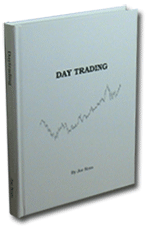Displaying items by tag: forex trading
Day Trading
A Complete Day Trading Course in One Book

"Joe and I have been friends for some time. We have collaborated on trading techniques, so I know of his dedication to the market. But in this book we see the other side of Joe -- the instructor of the grand style. He is teaching us "How to Fish." ~W. E. Dalton, MD
This book is a must-read for every serious day trader. It's the essence of Joe Ross' experience of well over five decades of trading the international markets. Although the focus is on day trading, it teaches you methods and concepts that are applicable in position trading as well.
Many traders fail because of a wrong mindset and the fact that they don't know where to start or what to expect as an outcome. This could be the most important book you’ll ever read. Joe has organized it in a clear, step-by-step manner. Instead of being overwhelmed, you'll have a clear trading plan. You'll know exactly where to start, what to do next, and where you can realistically expect to end up.
Day Trading Highlights
Chart Reading
This covers what you need to know about the "Law of Charts" and the simple tricks of how to use it in your trading. "A chart is a chart is a chart." The immediate psychology of a market is reflected in the price action. You don’t really need any indicators. We'll show you how a bar chart can reveal very powerful price patterns when you understand the proper interpretation and implementation.
Identifying Congestions and Trend Finding
In trading, it is equally important to be able to recognize congestion at the earliest possible time, and to identify a trend before everybody else sees that it is happening. We call it "identifying a trend while it is still in the birth canal," and shows you several methods of doing just that.
Markets are in congestion areas much longer than they are in trends. The early parts of the book center almost entirely around congestion areas, which may be seen on any chart in any time frame. Later in the book, the concepts and the techniques taught center around trending formations.
Let us show you how to spot the very beginning of a trend, and how to successfully enter existing and established trends. You will see and learn very simple and basic ways to trade. The main features of our methods show you early in the game what might happen next, and thus gets you on board a trend while it is "still in the birth canal."
Your own Trading Plan
You will find out if day trading is or is not suitable for you. It takes certain character traits and certain trading techniques to be a successful day trader. We'll described these, and also how you should combine them so that you write and follow your own trading plan. You will understand why you must want it your way, and why you should take only trades that "have your name on them."
The trading plan includes all the preparation and the actions you will take, such as: establishing entries, all potential orders, setting alerts, accommodating for gap openings, and, if you are filled, what you do until the exit of all your contract sets.
Trading Mindset
In Joe's unique way, he shows you how your own mind can help you become a successful trader or can break you apart. Trading is mainly a psychological endeavor, and the way you perceive the markets, coupled with your emotional reactions, actually determine your success or failure as a trader. It's simple advice to anyone who wants to trade: work to learn how to understand price movement.
By using powerful real life examples, we can demonstrate why trading has to be simple, despite the example of most traders who are in a never-ending search for complicated methods. Also, demystifying several relevant, but confusing concepts, such as those of "support and resistance," "oversold and overbought," and some of the overly used indicators that are not needed in order to trade profitably.
Entry Signals
We reveal major, minor, and intermediate intraday trading signals showing you exactly what they are, and explain why they are important. When you day trade, you want explosive moves after your entry. It is therefore crucial to scale down entry signals based on different time frames so that you get the greatest magnitude of movement once in the trade. This is a unique approach that has been developed and refined over decades of trading.
Searching Out the Best, and Trade Filtering
One of the most important things that any trader can learn to do is to identify the best trades. These can differ from one person to another because we see trades differently, and not everyone trades in the same way. But everyone can learn to recognize what happens in the markets that result in successful trades. Then the trick is to stick to it like glue - until it stops working.
We'll show you exactly what to be comfortable with, while keeping your trading as your own. Examples going into full details of how you should see the whole trade setup, how to think, and select the trades, so that you can adapt that knowledge to your own comfort level.
Let us explain how a trading filter serves several purposes. You will learn how to use a trading filter to calibrate your stop, and to avoid false breakouts as well. You will be able to anticipate breakouts, and thus get into the trade earlier than you might otherwise have done.
Risk and Money Management
We will show you one of the finest points of Joe Ross' trading: his philosophy of money and risk management. These two concepts overlap, and yet they are different. Risk management says "I can afford to risk only so much," while money management asks "What can I expect to make for the risk I have taken?" You will understand why he says that trading is a business and why, the sooner one treats it that way, the sooner one will become a winner.
Placing Stops
The most frequent question we have been asked at Trading Educators is "Where do I put my stop?" Stop placement is a function of a number of variables. There are three kinds of stops: protective, objective, and time stops. It is vital to understand the role of each of these stops and to use them accordingly within your own trading plan.
Unfortunately, most traders place stops where they don’t make any sense, such as at a certain percentage away from the entry. We'll teach you how to place your stops in a practical manner that takes into consideration both technical factors and your own comfort level.
Brokers and Commissions
There is nothing more important in day trading than to have a responsive, accurate, reliable broker handling your account. Offering you several real-life examples of our experiences with brokers that will really make you think. He helps you consider all the vital factors such as commissions, margins, speed of execution, and reliable customer service when you desperately need it.
You will understand why brokers are in this business. You really need to know how to take advantage of your broker’s strengths, and how to avoid losing money because of their weaknesses. You will learn how to choose a reliable broker and build a solid relationship with him or her, one that works well for you.
E-Mini S&P 500 Trading
We dedicate a section to traders who like to day trade the E-Mini S&P 500, but starts it with a word of caution: we have seen too many otherwise good traders destroyed by trading the five-minute chart in the S&P E-Mini. Getting into the E-Mini is like stepping into the ring with a rattlesnake: you can be bitten quickly, and when you least expect it.
We will show you several examples, so that you realize that trading with the short term charts requires making decisions quickly. You have plenty of examples of preparation for the trading session, entry signals, and trade management. You learn why you don’t have to trade too often and too much, especially when trading the E-Mini. We'll also show you why trade selection is in large part responsible for trading it successfully.
g>Forex Trading
You will learn what Forex is, why it exists, and the main terms that characterize a forex trading account. We then tell you the most important things you need to know about forex regulation and brokers. You need to know the concepts and the realities of how a bucket shop operates, about the leaning and skewing of prices, as well as the myths of "free streaming data" and the "guaranteed fills".
There is a full chapter dedicated to a forex method that Joe Ross uses. You will learn in detail the 19 rules of the method, and be guided through preparation, entry, risk management, and profit management. There are several chart examples and detailed instructions accompanying each rule.
Day Trading and Position Trading
At the beginning of the book, Joe takes you through the definition of day trading, and compares it with position trading. We'll show you the similarities and the differences between the two. You learn the advantages and the disadvantages of each of them. You discover the benefits of one over the other. But most importantly, you learn that "a chart is a chart is a chart," and that's why the techniques and the concepts shown in this book work in both day trading and position trading.
Day Trading is a complete revision of Joe's classic Trading by the Minute, one of the most popular books on intraday trading ever written. It has become a classic in its time. This revised book is a day trading course that is a "must read" for online day trading.
If you are an online electronic day trader, you will refer to this book time and time again. Joe has taught thousands of people how to day trade.
Commonly Asked Question
What's the difference between the Day Trading book, the Day Trading E-Mini S&P 500 eBook, and the Day Trading Forex eBook?
The Day Trading hardback book is a full-sized textbook that is loaded with lessons, examples taken from real trades, and reveals many concepts to succeed at trading. The Day Trading E-Mini S&P 500 eBook teaches you how to day trade in almost any market, along with some concepts that go beyond what is in the Day Trading book, and focuses specifically on the E-Mini S&P 500. The Day Trading Forex eBook teaches concepts that are not in the other two products; it can be used in a variety of markets, but focuses on Forex.
Learn Master Trader Joe Ross' Tricks and Inside Information from this Book

"I would recommend Joe's book on day trading to anyone interested in learning about this subject and wants to hear about it from someone who practices what he preaches. It is apparent from the book that Joe knows the reality of trading markets rather than the theory. I have recently assessed my trading for the last 3 months and am beginning to (at last!) turn in a profit. This is due partly to the help given in this book. Thanks Joe!" ~Jon Martin
"This is a WONDERFUL exposition of what it takes to be successful in the trading profession. Rich in its descriptions of proper ATTITUDE, THOUGHT PATTERNS, and SELF-KNOWLEDGE --- all of them the keys to profit. Just as valuable is Joe's placing indicators, high-powered math, statistics, and complex theory in their proper perspective, namely that they are typically DISTRACTIONS rather than aids, in comparison to learning THE DETAILS of price action. In the same vein, Joe emphasizes the value of DISCRETIONARY trading compared to MECHANICAL trading, making the point that since all markets change over time, sooner or later a rigid, inflexible system not being able to adapt, will fail." ~Bill Schenker
$150.00
Dimensions: H 11 1/4" x W 8 5/8"
327 pages
30-Day Money Back Guarantee*
Hardcover Only
*If you aren't thrilled with Day Trading, just send it back within 30 days and we'll refund 100% of your purchase price (less s&h).
- markets
- income
- options trading education
- stock market
- day trading
- trading techniques
- position trading
- bar chart
- congestions
- trend finding
- identify trends
- trading plan
- setting alerts
- price movement
- intraday trading signals
- identify best trades
- risk management
- money management
- placing stops
- stop placement
- emini s&p 500 trading
- trade management
- forex
- forex trading
- trading logic
- traders trick entry
- entry signals
Train for the Future
An Essential Ingredient for a Profitable Trading Life!

Recommended for traders at all levels, beginners all the way through to advanced.
Can you believe it? Over the years, Joe Ross has come to realize that many traders, perhaps most traders, are unable to give a correct answer to the questions listed below:
-
What is the "settlement price?"
-
Is there a buyer and seller of last resort when trading futures?
-
What is backwardation?
-
How are feeder cattle contracts settled? How are live cattle contracts settled?
-
What does the study called "Stochastics" measure?
-
Name two indicators that can be used to give true confirmation of one another as well as of the price action?
-
Define the two kinds of FCMs?
-
Define the two kinds of IBs?
-
Is anyone required to make a market in futures, and if so, when?
-
What is a clearing firm?
-
Why is your money safer with a futures broker than with a forex broker?
How did you do? Did you know the answers? Are you sure?
Asking you this series of questions was the best way to help you determine if you need our guidance. "Futures - From The Beginning" don't let the name fool you. This eBook has information for traders at all levels, from beginners all the way through to advanced. Whether you've been trading for years or are just a beginner, there is detailed information about this business that most traders do not know, and are unaware that they need to know. If you're lucky, you might find this information on the web, but you might have to read through thousands of pages to get it. However, in "Futures - From The Beginning," you will find the answers all in one place.
Example 1: You are trading a Eurodollar spread. You give the broker your order: "Buy one December 2006 Eurodollar and sell one December 2007 Eurodollar at a spread of 52, premium to the buy side. After awhile the spread comes back and it is filled. You look at the individual legs of the spread and realize that the fill you received for the December 2006 contract was at a price beyond the limits of the prices traded throughout the entire day. What recourse do you have? Do you need recourse? Was the fill legitimate?
If you trade spreads, regardless of which markets, you need to know the answer. The answers are available in this course.
Example 2: You enter a euro fx trade from your electronic trading platform. Prices move into a trading range and continue to move sideways for awhile. Suddenly you realize that the prices on your screen have stopped ticking. You check your computer and it seems to be working. To be sure, you reboot. Nothing changes, still no ticking. You call your broker and he tells you the exchange computer is down. After about an hour the exchange computer comes back up, and you are facing a substantial loss. Do you have to eat that loss? Do you have recourse?
"Futures - From The Beginning" gives you the answers - all in one place.
Example 3: You bought an in-the-money Put option and prices have moved up. The Put is now out of the money, and your option is within a few days of expiration. The broker issues you a margin call. Can he do that?
Example 4: You are long a soybean contract. Somehow first notice day slipped past your attention and you discover that you have been assigned to take delivery. What are your options?
Example 5: You are short a Call option. The option finishes in the money and the option is called away from you. What does that mean? What is your position? What do you have to do?
Example 6: You are trading forex and are long. The trade has you with a very small gain, so you decide to hold overnight. What impact does that have on your account?
Example 7: You decide to trade Crude Oil futures at the NYMEX. You enter with a market order. You do not receive a fill for 45 minutes. Is that allowable for a market order?
If you are not sure of the solution to every one of the seven examples, then you will some day find yourself facing serious difficulties.
Did you know that there is a better way than a moving average to follow a trend? You will discover that way in this eBook, along with a method for staying with a longer term trend. That doesn't mean that you have to trade the daily, weekly, or monthly charts to realize the benefits from what we will show you.
We've seen a market trend for 400 price bars on a one-minute chart in the British Pound. That's the equivalent of two years of trading on a daily chart. You can trade a trend like that.
You can increase your chances for trading success when you know and understand the business of trading.
The more you know, the better off you will be. You need to know the rules and the players; you need to know what can hurt you and what can help you.
For instance, so many traders seek to acquire confirmation from two or more indicators that are all measuring the same thing. You can chase your tail round and round like a dog with an itch, but you will gain nothing from your pursuit when all the indicators are duplicating each other. What we're saying here is that many traders will use more than one momentum indicator, or more than one volatility indicator, to confirm not the price action, but to confirm a different indicator of the same type, measuring the same thing. But that's not the way to do it. The correct way is revealed.
There is more, much more, contained in the 21 Lessons. We feel this is information every trader should know, but that all too many do not know. The course will give you the facts you need to make important decisions.
You've waited long enough. Every day that you trade without this vital information puts you at greater risk.
$239.00
Futures - From The Beginning
eBook
Orders Filled Within 24 Hours*
All Sales Final on Digital Products
*IMPORTANT: Your order will be fulfilled within 24-hours during our regular business hours containing your access information. Please contact us if you did not receive our email. Be sure to check your junk/spam folder before contacting us. All sales are final.





